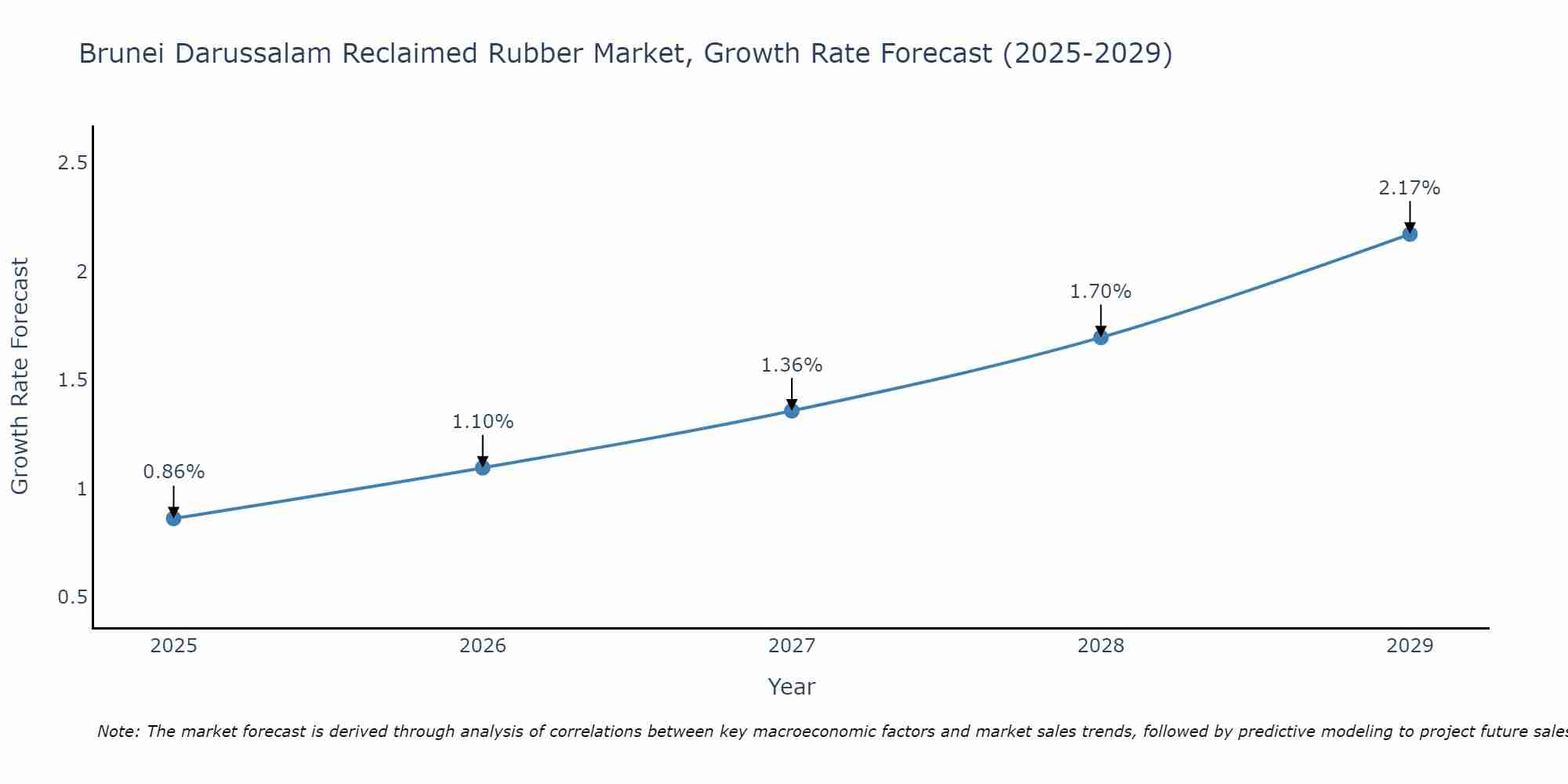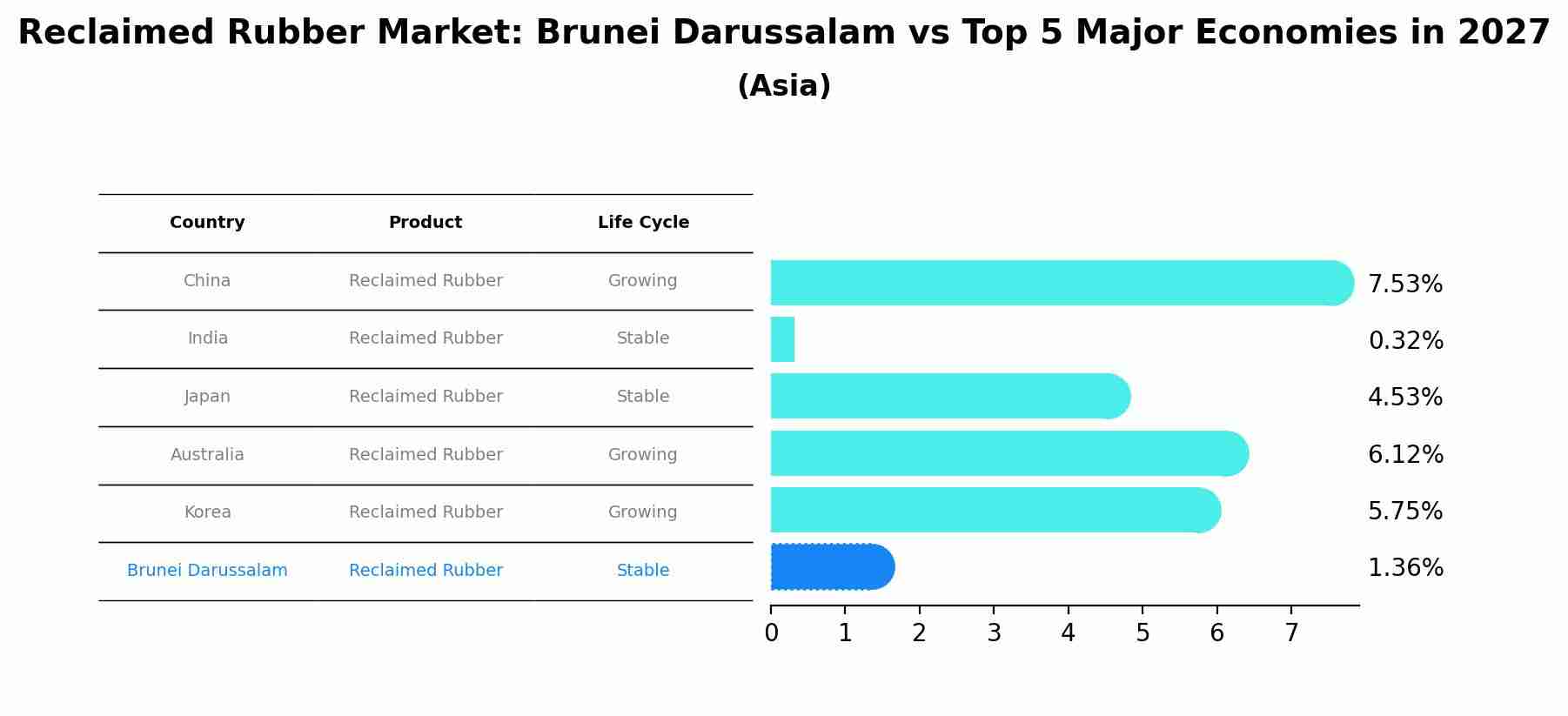Brunei Reclaimed Rubber Market (2025-2031) | Analysis, Industry, Forecast, Outlook, Share, Growth, Segmentation, Trends, Companies, Value, Size & Revenue
| Product Code: ETC4711269 | Publication Date: Nov 2023 | Updated Date: Apr 2025 | Product Type: Market Research Report | |
| Publisher: 6Wresearch | Author: Shubham Deep | No. of Pages: 60 | No. of Figures: 30 | No. of Tables: 5 |
Brunei Darussalam Reclaimed Rubber Market Size Growth Rate
The Brunei Darussalam Reclaimed Rubber Market is likely to experience consistent growth rate gains over the period 2025 to 2029. From 0.86% in 2025, the growth rate steadily ascends to 2.17% in 2029.

Reclaimed Rubber Market: Brunei Darussalam vs Top 5 Major Economies in 2027 (Asia)
By 2027, Brunei Darussalam's Reclaimed Rubber market is forecasted to achieve a stable growth rate of 1.36%, with China leading the Asia region, followed by India, Japan, Australia and South Korea.

Brunei Reclaimed Rubber Market Overview
The reclaimed rubber market in Brunei is driven by the need for sustainable and cost-effective alternatives to virgin rubber. This market focuses on the recycling of used rubber products, such as tires, into usable materials. Key factors influencing this market include environmental regulations, cost savings, and advancements in recycling technologies. The growing demand for eco-friendly materials in various industries, such as automotive and construction, also supports the expansion of the reclaimed rubber market in Brunei.
Drivers of the market
The Brunei reclaimed rubber market is driven by the growing emphasis on sustainability and the need to manage waste effectively. As environmental regulations become more stringent, there is an increasing demand for recycled materials to reduce waste and conserve natural resources. The automotive and manufacturing industries are significant contributors to this demand, as reclaimed rubber is used in various applications such as tires, seals, and gaskets. Additionally, the economic benefits of using reclaimed rubber over virgin rubber, including cost savings and reduced dependence on raw materials, further propel market growth.
Challenges of the market
The reclaimed rubber market in Brunei faces several challenges. The primary issue is the limited supply of high-quality reclaimed rubber, which impacts production consistency and performance. Additionally, there is a lack of technological advancements in the recycling processes, leading to lower efficiency and higher costs. The market also struggles with regulatory hurdles related to environmental standards and quality control. Furthermore, the market is hindered by competition from imported virgin rubber products, which can be more appealing to manufacturers due to their superior properties.
Government Policy of the market
The Brunei government encourages sustainable practices and recycling to minimize environmental impact. Policies are in place to support the use of eco-friendly materials, including tax incentives for companies utilizing recycled products such as reclaimed rubber. This aligns with Brunei`s broader environmental conservation goals and supports the circular economy initiatives in the country.
Key Highlights of the Report:
- Brunei Reclaimed Rubber Market Outlook
- Market Size of Brunei Reclaimed Rubber Market, 2024
- Forecast of Brunei Reclaimed Rubber Market, 2031
- Historical Data and Forecast of Brunei Reclaimed Rubber Revenues & Volume for the Period 2021-2031
- Brunei Reclaimed Rubber Market Trend Evolution
- Brunei Reclaimed Rubber Market Drivers and Challenges
- Brunei Reclaimed Rubber Price Trends
- Brunei Reclaimed Rubber Porter`s Five Forces
- Brunei Reclaimed Rubber Industry Life Cycle
- Historical Data and Forecast of Brunei Reclaimed Rubber Market Revenues & Volume By Product for the Period 2021-2031
- Historical Data and Forecast of Brunei Reclaimed Rubber Market Revenues & Volume By Whole Tire Reclaim (WTR) for the Period 2021-2031
- Historical Data and Forecast of Brunei Reclaimed Rubber Market Revenues & Volume By Butyl Reclaim for the Period 2021-2031
- Historical Data and Forecast of Brunei Reclaimed Rubber Market Revenues & Volume By EPDM for the Period 2021-2031
- Historical Data and Forecast of Brunei Reclaimed Rubber Market Revenues & Volume By Drab & Colored for the Period 2021-2031
- Historical Data and Forecast of Brunei Reclaimed Rubber Market Revenues & Volume By Others for the Period 2021-2031
- Historical Data and Forecast of Brunei Reclaimed Rubber Market Revenues & Volume By Application for the Period 2021-2031
- Historical Data and Forecast of Brunei Reclaimed Rubber Market Revenues & Volume By Automotive & Aircraft Tires for the Period 2021-2031
- Historical Data and Forecast of Brunei Reclaimed Rubber Market Revenues & Volume By Cycle Tires for the Period 2021-2031
- Historical Data and Forecast of Brunei Reclaimed Rubber Market Revenues & Volume By Retreading for the Period 2021-2031
- Historical Data and Forecast of Brunei Reclaimed Rubber Market Revenues & Volume By Belts & Hoses for the Period 2021-2031
- Historical Data and Forecast of Brunei Reclaimed Rubber Market Revenues & Volume By Footwear for the Period 2021-2031
- Historical Data and Forecast of Brunei Reclaimed Rubber Market Revenues & Volume By Molded Goods for the Period 2021-2031
- Historical Data and Forecast of Brunei Reclaimed Rubber Market Revenues & Volume By Others for the Period 2021-2031
- Brunei Reclaimed Rubber Import Export Trade Statistics
- Market Opportunity Assessment By Product
- Market Opportunity Assessment By Application
- Brunei Reclaimed Rubber Top Companies Market Share
- Brunei Reclaimed Rubber Competitive Benchmarking By Technical and Operational Parameters
- Brunei Reclaimed Rubber Company Profiles
- Brunei Reclaimed Rubber Key Strategic Recommendations
Frequently Asked Questions About the Market Study (FAQs):
1 Executive Summary |
2 Introduction |
2.1 Key Highlights of the Report |
2.2 Report Description |
2.3 Market Scope & Segmentation |
2.4 Research Methodology |
2.5 Assumptions |
3 Brunei Reclaimed Rubber Market Overview |
3.1 Brunei Country Macro Economic Indicators |
3.2 Brunei Reclaimed Rubber Market Revenues & Volume, 2021 & 2031F |
3.3 Brunei Reclaimed Rubber Market - Industry Life Cycle |
3.4 Brunei Reclaimed Rubber Market - Porter's Five Forces |
3.5 Brunei Reclaimed Rubber Market Revenues & Volume Share, By Product, 2021 & 2031F |
3.6 Brunei Reclaimed Rubber Market Revenues & Volume Share, By Application, 2021 & 2031F |
4 Brunei Reclaimed Rubber Market Dynamics |
4.1 Impact Analysis |
4.2 Market Drivers |
4.3 Market Restraints |
5 Brunei Reclaimed Rubber Market Trends |
6 Brunei Reclaimed Rubber Market Segmentations |
6.1 Brunei Reclaimed Rubber Market, By Product |
6.1.1 Overview and Analysis |
6.1.2 Brunei Reclaimed Rubber Market Revenues & Volume, By Whole Tire Reclaim (WTR), 2021-2031F |
6.1.3 Brunei Reclaimed Rubber Market Revenues & Volume, By Butyl Reclaim, 2021-2031F |
6.1.4 Brunei Reclaimed Rubber Market Revenues & Volume, By EPDM, 2021-2031F |
6.1.5 Brunei Reclaimed Rubber Market Revenues & Volume, By Drab & Colored, 2021-2031F |
6.1.6 Brunei Reclaimed Rubber Market Revenues & Volume, By Others, 2021-2031F |
6.2 Brunei Reclaimed Rubber Market, By Application |
6.2.1 Overview and Analysis |
6.2.2 Brunei Reclaimed Rubber Market Revenues & Volume, By Automotive & Aircraft Tires, 2021-2031F |
6.2.3 Brunei Reclaimed Rubber Market Revenues & Volume, By Cycle Tires, 2021-2031F |
6.2.4 Brunei Reclaimed Rubber Market Revenues & Volume, By Retreading, 2021-2031F |
6.2.5 Brunei Reclaimed Rubber Market Revenues & Volume, By Belts & Hoses, 2021-2031F |
6.2.6 Brunei Reclaimed Rubber Market Revenues & Volume, By Footwear, 2021-2031F |
6.2.7 Brunei Reclaimed Rubber Market Revenues & Volume, By Molded Goods, 2021-2031F |
7 Brunei Reclaimed Rubber Market Import-Export Trade Statistics |
7.1 Brunei Reclaimed Rubber Market Export to Major Countries |
7.2 Brunei Reclaimed Rubber Market Imports from Major Countries |
8 Brunei Reclaimed Rubber Market Key Performance Indicators |
9 Brunei Reclaimed Rubber Market - Opportunity Assessment |
9.1 Brunei Reclaimed Rubber Market Opportunity Assessment, By Product, 2021 & 2031F |
9.2 Brunei Reclaimed Rubber Market Opportunity Assessment, By Application, 2021 & 2031F |
10 Brunei Reclaimed Rubber Market - Competitive Landscape |
10.1 Brunei Reclaimed Rubber Market Revenue Share, By Companies, 2024 |
10.2 Brunei Reclaimed Rubber Market Competitive Benchmarking, By Operating and Technical Parameters |
11 Company Profiles |
12 Recommendations | 13 Disclaimer |
- Single User License$ 1,995
- Department License$ 2,400
- Site License$ 3,120
- Global License$ 3,795
Search
Related Reports
- Portugal Electronic Document Management Market (2025-2031) | Strategy, Consumer Insights, Analysis, Investment Trends, Opportunities, Growth, Size, Share, Industry, Revenue, Segments, Value, Segmentation, Supply, Forecast, Restraints, Outlook, Competition, Drivers, Trends, Demand, Pricing Analysis, Competitive, Strategic Insights, Companies, Challenges
- France Electronic Document Management Market (2025-2031) | Strategy, Consumer Insights, Analysis, Investment Trends, Opportunities, Growth, Size, Share, Industry, Revenue, Segments, Value, Segmentation, Supply, Forecast, Restraints, Outlook, Competition, Drivers, Trends, Demand, Pricing Analysis, Competitive, Strategic Insights, Companies, Challenges
- Portugal Occupational Health & Safety Services Market (2025-2031) | Strategy, Consumer Insights, Analysis, Investment Trends, Opportunities, Growth, Size, Share, Industry, Revenue, Segments, Value, Segmentation, Supply, Forecast, Restraints, Outlook, Competition, Drivers, Trends, Demand, Pricing Analysis, Competitive, Strategic Insights, Companies, Challenges
- Netherlands Occupational Health and Safety Services Market (2025-2031) | Strategy, Consumer Insights, Analysis, Investment Trends, Opportunities, Growth, Size, Share, Industry, Revenue, Segments, Value, Segmentation, Supply, Forecast, Restraints, Outlook, Competition, Drivers, Trends, Demand, Pricing Analysis, Competitive, Strategic Insights, Companies, Challenges
- Belgium and Luxembourg Facility Management Market (2025-2031) | Strategy, Consumer Insights, Analysis, Investment Trends, Opportunities, Growth, Size, Share, Industry, Revenue, Segments, Value, Segmentation, Supply, Forecast, Restraints, Outlook, Competition, Drivers, Trends, Demand, Pricing Analysis, Competitive, Strategic Insights, Companies, Challenges
- Russia Women Intimate Apparel Market (2025-2031) | Strategy, Consumer Insights, Analysis, Investment Trends, Opportunities, Growth, Size, Share, Industry, Revenue, Segments, Value, Segmentation, Supply, Forecast, Restraints, Outlook, Competition, Drivers, Trends, Demand, Pricing Analysis, Competitive, Strategic Insights, Companies, Challenges
- Africa Chocolate Market (2025-2031) | Size, Share, Trends, Growth, Revenue, Analysis, Forecast, industry & Outlook
- Global Hydroxychloroquine And Chloroquine Market (2025-2031) | Industry, Trends, Size, Outlook, Growth, Value, Companies, Revenue, Analysis, Share, Forecast
- Saudi Arabia Plant Maintenance Market (2025-2031) | Industry, Size, Growth, Revenue, Value, Companies, Forecast, Analysis, Share & Trends
- Taiwan Electric Truck Market (2025-2031) | Outlook, Industry, Revenue, Size, Forecast, Growth, Analysis, Share, Companies, Value & Trends
Industry Events and Analyst Meet
Our Clients
Whitepaper
- Middle East & Africa Commercial Security Market Click here to view more.
- Middle East & Africa Fire Safety Systems & Equipment Market Click here to view more.
- GCC Drone Market Click here to view more.
- Middle East Lighting Fixture Market Click here to view more.
- GCC Physical & Perimeter Security Market Click here to view more.
6WResearch In News
- Doha a strategic location for EV manufacturing hub: IPA Qatar
- Demand for luxury TVs surging in the GCC, says Samsung
- Empowering Growth: The Thriving Journey of Bangladesh’s Cable Industry
- Demand for luxury TVs surging in the GCC, says Samsung
- Video call with a traditional healer? Once unthinkable, it’s now common in South Africa
- Intelligent Buildings To Smooth GCC’s Path To Net Zero













